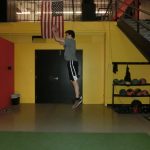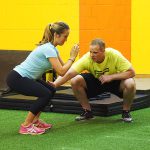The Crucial and Often Overlooked Phase of Acceleration
Everyone wants to get faster. The best and fastest way to get faster is to improve your technique. But, understanding and defining what getting faster means (is it for the 40-yard dash or for your sport) is critical for teaching proper technique. You shouldn’t be coaching acceleration to a track athlete the same as you would to a tennis athlete as the task objectives are different. This blog will keep the focus on acceleration in a non-track setting. The part of the acceleration we are talking about is the first 3-5 steps.
It is import to understand what is trying to be accomplished with each acceleration step. I have found that many athletes and coaches alike don’t really understand the purpose of these steps. If we think about Newton’s 3rd Law stating, for every action there is an equal and opposite reaction, and apply it to acceleration it tells us that the force that is propelling you forward is coming from the ground, not our body. The amount and direction of the force we push with into the ground is the determinate of how much and in what direction the ground is pushing back on us propelling us forward, or in any other direction desired for that matter.
When you think about acceleration this way we can see that you want the body to create a force in a backward direction in order to go forward. Thus, if someone is running too high one of the reason why might be that they are creating too much force into the ground in a downwards direction, which results in them popping or coming up. It is an outdated thought to be teaching about stride length and stride frequency for this reason as it does not take into account the force going into the ground. They are by-products of correctly creating a greater force in a more optimal direction, not necessarily coaching point you should highlight.
So what are better coaching points? If you are looking at just going in a linear direction, as opposed to having to turn first, it’s simpler to understand. The athlete should be instructed on pushing the ground away from them in the direction that they want to go. The greater force that they do this with the greater the propel they will get going forward creating a better lean. If you are trying to create as much force as possible two things should happen. First, you have to have a proper extension of the hip, knee, and ankle. Second, you have to get your foot back to the ground in an efficient direction and time. Focusing your time to coaching these aspects as opposed to stride length and frequency will serve your athlete better in the long run.
The acceleration out of a break or turn when changing direction is vital for sport performance. However, it is one of the biggest movement flaws that I see in athletes. Again, it all comes down to creating a force in an optimal direction. Often the first steps are too long with the athlete reaching out in front of them for the ground as opposed to pushing the ground away from the direction that they want to go. Take for instance, if you are going to accelerate laterally 90 degrees, like a baseball player stealing a base or a volleyball player closing out for a block, the inside foot should step back while the outside foot is pushing the ground away from the direction you want to go. If the step is forward, the ground is going to be pushing back into you, placing the lower body in a disadvantaged position to extend and push the ground backward, which then takes longer to get the foot back to the ground for its next stride; all things which lead to slowing you down. Instead, the inside foot should step back in order to drive the ground away from you while the opposite leg is pushing the ground away from you in the direction that you want to go.
This is a very brief explanation of the first 3-5 steps of acceleration and explaining what their purpose is. In order to coach and train the body to have better acceleration, this understanding is vital. The actual coaching and training methods in order to get this to happen are far more complicated and couldn’t be done justice in a simple blog. Hopefully, this will give you a better understanding of how to think about acceleration and its purpose in order to get faster.





